- Hijab
-
"Higab" redirects here. For the municipal company of Gothenburg, Sweden, see Higabgruppen.
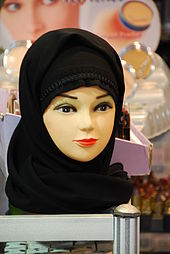 The standard typical hijab headscarf worn on the head of a mannequin.
The standard typical hijab headscarf worn on the head of a mannequin.
Part of a series on Islamic
jurisprudence
(Fiqh)PoliticalEtiquetteIslamic studies 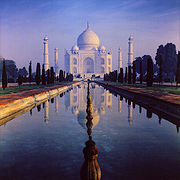
Part of a series on
Islamic culture
Architecture Arabic · Azeri
Indo-Islamic · Iwan
Moorish · Moroccan · Mughal
Ottoman · Persian · Somali
Sudano-Sahelian · TatarArt Calligraphy · Miniature · Rugs
Dress Abaya · Agal · Boubou
Burqa · Chador · Jellabiya
Niqab · Salwar kameez · Taqiya
kufiya · Thawb · Jilbāb · HijabHolidays Ashura · Arba'een · al-Ghadeer
Chaand Raat · al-Fitr · al-Adha
Imamat Day · al-Kadhim
New Year · Isra and Mi'raj
al-Qadr · Mawlid · Ramadan
Mugam · Mid-Sha'ban
al-TaiyyabLiterature Arabic · Azeri · Bengali
Indonesian · Javanese · Kashmiri
Kurdish · Persian · Punjabi · Sindhi
Somali · South Asian · Turkish · UrduThe word "hijab" or "ḥijāb" (Arabic: حجاب hijaab, pronounced [ħiˈdʒæːb] ~ [ħiˈɡæːb]) refers to both the head covering traditionally worn by Muslim women and modest Muslim styles of dress in general.
The Arabic word literally means curtain or cover (noun). Most Islamic legal systems define this type of modest dressing as covering everything except the face and hands in public.[1][2] According to Islamic scholarship, hijab is given the wider meaning of modesty, privacy, and morality;[3] the words for a headscarf or veil used in the Qur'an are khimār (خمار) and jilbaab (جلباب), not hijab. Still another definition is metaphysical, where al-hijab refers to "the veil which separates man or the world from God."[2]
Muslims differ as to whether the hijab should be required on women in public, as it is in countries like Iran and Saudi Arabia; whether it should be banned in schools, as it is in France and Turkey; or whether it should be left for the women to decide, as it is in the United States.
Contents
Etymology and meaning
According to the Encyclopedia of Islam and the Muslim World, the meaning of hijab has evolved over time:
The term hijab or veil is not used in the Qur'an to refer to an article of clothing for women or men, rather it refers to a spatial curtain that divides or provides privacy. The Qur'an instructs the male believers (Muslims) to talk to wives of Prophet Muhammad behind a hijab. This hijab was the responsibility of the men and not the wives of Prophet Muhammad. However, in later Muslim societies this instruction, specific to the wives of Prophet Muhammad, was generalized, leading to the segregation of the Muslim men and women. The modesty in Qur'an concerns both men's and women's gaze, gait, garments, and genitalia. The clothing for women involves khumūr over the necklines and jilbab (cloaks) in public so that they may be identified and not harmed. Guidelines for covering of the entire body except for the hands, the feet and the face, are found in texts of fiqh and hadith that are developed later.[4]In Islamic texts
Qur'an
The Qur'an instructs both Muslim men and women to dress in a modest way.
The clearest verse on the requirement of the hijab is surah 24:30–31, asking women to draw their khimār over their bosoms.[5][6]
And say to the believing women that they should lower their gaze and guard their modesty; that they should not display their beauty and ornaments except what (must ordinarily) appear thereof; that they should draw their khimār over their bosoms and not display their beauty except to their husbands, their fathers, their husband's fathers, their sons, their husbands' sons, their brothers or their brothers' sons, or their sisters' sons, or their women, or the slaves whom their right hands possess, or male servants free of physical needs, or small children who have no sense of the shame of sex; and that they should not strike their feet in order to draw attention to their hidden ornaments. (Quran 24:31)In the following verse, Muslim women are asked to draw their jilbab over them (when they go out), as a measure to distinguish themselves from others, so that they are not harassed. Surah 33:59 reads:[6]
Those who harass believing men and believing women undeservedly, bear (on themselves) a calumny and a grievous sin. O Prophet! Enjoin your wives, your daughters, and the wives of true believers that they should cast their outer garments over their persons (when abroad): That is most convenient, that they may be distinguished and not be harassed. [...] (Quran 33:58–59)Alternative views
Other Muslims take a relativist approach to ħijāb. They believe that the commandment to maintain modesty must be interpreted with regard to the surrounding society. What is considered modest or daring in one society may not be considered so in another. It is important, they say, for believers to wear clothing that communicates modesty and reserve.[7]
Other verses do mention separation of men and women but, however, they refer specifically to the wives of the prophet:
According to Leila Ahmed, nowhere in the whole of the Qur'an is the term hijab applied to any woman other than the wives of Muhammad.[8][9]
According to at least two authors (Reza Aslan and Leila Ahmed), the stipulations of the hijab were originally meant only for Muhammad's wives, and were intended to maintain their inviolability. This was because Muhammad conducted all religious and civic affairs in the mosque adjacent to his home:
People were constantly coming in and out of this compound at all hours of the day. When delegations from other tribes come to speak with Prophet Muhammad, they would set up their tents for days at a time inside the open courtyard, just a few feet away from the apartments in which Prophet Muhammad's wives slept. And new emigrants who arrived in Yatrib would often stay within the mosque's walls until they could find suitable homes.[8]According to Ahmed:
By instituting seclusion Prophet Muhammad was creating a distance between his wives and this thronging community on their doorstep.[10]They argue that the term darabat al-hijab ("taking the veil"), was used synonymously and interchangeably with "becoming Prophet Muhammad's wife", and that during Muhammad's life, no other Muslim woman wore the hijab. Aslam suggests that Muslim women started to wear the hijab to emulate Muhammad's wives, who are revered as "Mothers of the Believers" in Islam,[8] and states "there was no tradition of veiling until around 627 C.E." in the Muslim community.[8][10]
Hadith
The Arabic word jilbab is translated as "cloak" in the following passage. Contemporary salafis insist that the jilbab (which is worn over the Kimaar and covers from the head to the toe) worn today is the same garment mentioned in the Qur'an and the hadith; other translators have chosen to use less specific terms:
- Narrated Anas ibn Malik: "I know (about) the Hijab (the order of veiling of women) more than anybody else. Ubay ibn Ka'b used to ask me about it. Allah's Apostle became the bridegroom of Zaynab bint Jahsh whom he married at Medina. After the sun had risen high in the sky, the Prophet invited the people to a meal. Allah's Apostle remained sitting and some people remained sitting with him after the other guests had left. Then Allah's Apostle got up and went away, and I too, followed him till he reached the door of 'Aisha's room. Then he thought that the people must have left the place by then, so he returned and I also returned with him. Behold, the people were still sitting at their places. So he went back again for the second time, and I went along with him too. When we reached the door of 'Aisha's room, he returned and I also returned with him to see that the people had left. Thereupon the Prophet hung a curtain between me and him and the Verse regarding the order for (veiling of women) Hijab was revealed." Sahih al-Bukhari, 7:65:375, Sahih Muslim, 8:3334
- Narrated Umm Salama Hind bint Abi Umayya, Ummul Mu'minin: "When the verse 'That they should cast their outer garments over their persons' was revealed, the women of Ansar came out as if they had crows hanging down over their heads by wearing outer garments." 32:4090. Abū Dawud classed this hadith as authentic.
- Narrated Safiya bint Shaiba: "Aisha used to say: 'When (the Verse): "They should draw their veils (Khumur) over their necks and bosoms (juyyub)," was revealed, (the ladies) cut their waist sheets at the edges and covered their faces with the cut pieces.'" Sahih al-Bukhari, 6:60:282, 32:4091.
Dress code required by hijab
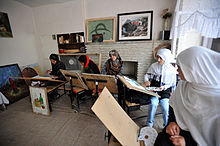 Female art students in Afghanistan.
Female art students in Afghanistan.
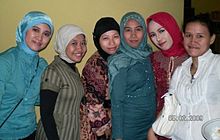 Indonesian women wearing hijab
Indonesian women wearing hijab
Traditionally, Muslims have recognized many different forms of clothing as satisfying the demands of hijab.[11] Debate focused on how much of the male or female body should be covered. Different scholars adopted different interpretations of the original texts.
Women
The four major Sunni schools of thought (Hanafi, Shafi'i, Maliki and Hanbali) hold that entire body of the woman, except her face and hands – though a few clerics[who?] say face, hands – is part of her awrah, that is, the parts of her body that must be covered during prayer and in public settings. There are those who allow the feet to be uncovered as well as the hands and face.[12][13]
It is recommended that women wear clothing that is not form fitting to the body: either modest forms of western clothing (long shirts and skirts), or the more traditional jilbāb, a high-necked, loose robe that covers the arms and legs. A khimār or shaylah, a scarf or cowl that covers all but the face, is also worn in many different styles. Some scholars encourage covering the face, while some follow the opinion that it is only not obligatory to cover the face and the hands but mustahab (Highly recommended). Other scholars oppose face covering, particularly in the west where the woman may draw more attention as a result. These garments are very different in cut than most of the traditional forms of ħijāb, and they are worn worldwide by Muslims.
Detailed scholarly attention has focused on prescribing female dress. Many Muslims believe that basic requirements mean that, in the presence of someone of the opposite sex other than a close family member (those within the prohibited degrees of marriage—see mahram) a woman should cover her body, and walk and dress in a way that does not draw sexual attention to her. Some believers go so far as to specify exactly which areas of the body must be covered. In some cases, this is everything but the eyes, but most require that women cover everything but the face and hands. In nearly all Muslim cultures, young girls are not required to wear a ħijāb. There is not a single agreed age when a woman should begin wearing a ħijāb—but in many Muslim countries, puberty is the dividing line.
In private, and in the presence of mahrams, rules on dress relax. However, in the presence of the husband, most scholars stress the importance of mutual freedom and pleasure of the husband and wife.[14]
Garments
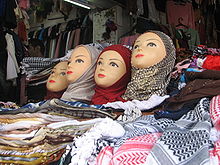 Women's head scarves for sale in Jerusalem
Women's head scarves for sale in Jerusalem
The burqa (also spelled burka) is the garment that covers women most completely: either only the eyes are visible, or nothing at all. Originating in what is now Pakistan, it is more commonly associated with the Afghan chadri. Typically, a burqa is composed of many yards of light material pleated around a cap that fits over the top of the head, or a scarf over the face (save the eyes). This type of veil is cultural as well as religious.
It has become tradition that Muslims in general, and Salafis in particular, believe the Qur'ān demands women wear the garments known today as jilbāb and khumūr (the khumūr must be worn underneath the jilbāb). However, Qur'ān translators and commentators translate the Arabic into English words with a general meaning, such as veils, head-coverings and shawls.[15] Ghamidi argues that verses [Quran 24:30] teach etiquette for male and female interactions, where khumūr is mentioned in reference to the clothing of Arab women in the 7th century, but there is no command to actually wear them in any specific way. Hence he considers head-covering a preferable practice but not a directive of the sharia (law).[16]
Men's dress
Although certain general standards are widely accepted, there has been little interest in narrowly prescribing what constitutes modest dress for Muslim men. Most mainstream scholars say that men should cover themselves from the navel to the knees; a minority say that the hadith that are held to require this are weak and possibly inauthentic. They argue that there are hadith indicating that the Islamic prophet Muħammad wore clothing that uncovered his thigh when riding camels, and hold that if Muħammad believed that this was permissible, then it is surely permissible for other Muslim males.[citation needed]
As a practical matter, however, the opinion that Muslim men must cover themselves between the navel and the knees is predominant, and most Muslims believe that a man who fails to observe this requirement during salah must perform the prayer again,[citation needed] properly covered, for it to be valid. Three of the four Sunni Madh'hab, or schools of law, require that the knees be covered; the Maliki school recommends but does not require knee covering.
According to some hadith, Muslim men are asked not to wear gold jewellery, silk clothing, or other adornments that are considered feminine. Some scholars say that these prohibitions should be generalized to prohibit the lavish display of wealth on one's person.[17]
Sartorial hijab as practiced
In more secular Muslim nations, such as Turkey or Tunisia, many women are choosing to wear the Hijab, Burqa, Niqab, etc. because of the widespread growth of the Islamic revival in those areas.[citation needed] Similarly, increasing numbers of men are abandoning the Western dress of jeans and t-shirts, that dominated places like Egypt 20 to 30 years ago, in favor of more traditional Islamic clothing such as the Galabiyya.[citation needed].
In Iran many women, especially younger ones, have taken to wearing transparent, colorful and very loosely worn Hijabs instead of Chadors or mantoos to protest but keep within the law of the state.
The colors of this clothing varies. It is mostly black, but in many African countries women wear clothes of many different colours depending on their tribe, area, or family. In Turkey, where the hijab is banned in private and state universities and schools, 11% of women wear it, though 60% wear traditional non-Islamic headscarves, figures of which are often confused with hijab.[18][19][20]
In many of the western nations, there has been a general rise of hijab-wearing women. They are especially common in Muslim Student Associations at college campuses.
Some Muslims have criticized strict dress codes that they believe go beyond the demands of hijab, using Qur'an 66:1 to apply to dress codes as well; the verse suggests that it is wrong to refrain from what is permitted by God.[citation needed]
Types of sartorial hijab
Main article: Sartorial hijabHistorical and cultural explanations
John Esposito, professor of Islamic Studies at Georgetown University, writes that the customs of veiling and seclusion of women in early Islam were assimilated from the conquered Persian and Byzantine societies and then later on they were viewed as appropriate expressions of Quranic norms and values. The Qur'an does not stipulate veiling or seclusion; on the contrary, it tends to emphasize the participation of religious responsibility of both men and women in society.[21] He claims that "in the midst of rapid social and economic change when traditional security and support systems are increasingly eroded and replaced by the state, (...) hijab maintains that the state has failed to provide equal rights for men and women because the debate has been conducted within the Islamic framework, which provides women with equivalent rather than equal rights within the family."[22]
Bloom and Blair also write that the Qur'an does not require women to wear veils; rather, it was a social habit picked up with the expansion of Islam. In fact, since it was impractical for working women to wear veils, "A veiled woman silently announced that her husband was rich enough to keep her idle."[23]
Modern practice
Wearing hijab in Kazakhstan is not prohibited, but widely criticized as a foreign custom (as traditional Central Asian scarfs worn by married womens like bandana, not like hijab), as it was not practiced until the fall of the USSR and the arrival of foreign Islamic missionaries.
Governmental enforcement and bans
 A map showing the prevalence of the Hijab[citation needed]
A map showing the prevalence of the Hijab[citation needed]
Some governments encourage and even oblige women to wear the hijab, while others have banned it in at least some public settings.
Some Muslims believe hijab covering for women should be compulsory as part of sharia, i.e. Muslim law. Wearing of the hijab was enforced by the Taliban regime in Afghanistan, and is enforced in the Kingdom of Saudi Arabia and in the Islamic Republic of Iran. The Islamic Emirate required women to cover not only their head but their face as well, because "the face of a woman is a source of corruption" for men not related to them.[24] While some women wholeheartedly embrace the rules, others protest by observing the rules in an inconsistent fashion, or flouting them whenever possible. Sudan's criminal code allows the flogging or fining of anyone who “violates public morality or wears indecent clothing”, albeit without defining "indecent clothing."
Turkey, Tunisia, and Tajikistan are Muslim-majority countries where the law prohibits the wearing of hijab in government buildings, schools, and universities. In Tunisia, women were banned from wearing hijab in state offices in 1981 and in the 1980s and 1990s more restrictions were put in place.[25] In 2008 the Turkish government attempted to lift a ban on Muslim headscarves at universities, but were overturned by the country's Constitutional Court.[26] Though in December 2010, the Turkish government ended the headscarf ban in universities.[27]
On March 15, 2004, France passed a law banning "symbols or clothes through which students conspicuously display their religious affiliation" in public primary schools, middle schools, and secondary schools. In the Belgian city of Maaseik, Niqāb has been banned.[28] (2006)
On July 13, 2010, France's lower house of parliament overwhelmingly approved a bill that would ban wearing the Islamic full veil in public. There were 335 votes for the bill and one against in the 557-seat National Assembly.
Non-governmental
See also: Islamization of the Gaza StripNon-governmental enforcement of hijab is found in many parts of the Muslim world.
Successful informal coercion of women by sectors of society to wear hijab has been reported in Gaza where Mujama' al-Islami, the predecessor of Hamas, reportedly used "a mixture of consent and coercion" to "'restore' hijab" on urban educated women in Gaza in the late 1970s and 1980s.[29]
Similar behavior was displayed by Hamas itself during the first intifada in Palestine. Though a relatively small movement at this time, Hamas exploited the political vacuum left by perceived failures in strategy by the Palestinian factions to call for a 'return' to Islam as a path to success, a campaign that focused on the role of women.[30] Hamas campaigned for the wearing of the hijab alongside other measures, including insisting women stay at home, segregation from men and the promotion of polygamy. In the course of this campaign women who chose not to wear the hijab were verbally and physically harassed, with the result that the hijab was being worn 'just to avoid problems on the streets'.[31]
According to journalist Jane Kramer, in France, veiling among school girls became increasingly common following the terrorist attacks of 11 September 2001, due to coercion by "fathers and uncles and brothers and even their male classmates" of the school girls. "Girls who did not conform were excoriated, or chased, or beaten by fanatical young men meting out Islamic justice."[32] According to the American magazine The Weekly Standard, a survey conducted in France in May 2003 reportedly "found that 77% of girls wearing the hijab said they did so because of physical threats from Islamist groups."[33]
In Srinagar, India in 2001 an "acid attack on four young Muslim women ... by an unknown militant outfit [was followed by] swift compliance by women of all ages on the issue of wearing the chadar (head-dress) in public."[34][35][36]
In Basra, Iraq, "more than 100 women who didn't adhere to strict Islamic dress code" were killed between the summer of 2007 and spring of 2008 by Islamist militias (primarily the Mahdi Army) who controlled the police there, according to the CBS news program 60 Minutes.[37]
Islamists in other countries have been accused of attacking or threatening to attack the faces of women in an effort to intimidate them from wearing of makeup or allegedly immodest dress.[38][39][40]
Hijab by country
Main article: Hijab by countrySee also
- Burqa
- Does My Head Look Big in This? (novel)
- Headscarf controversy in Turkey
- Hijab by country
- Islam and clothing
- List of types of sartorial hijab
- Chador
- Niqab
- Paranja
- Purdah
- Taliban treatment of women
- Tudong
- Veil
- Yashmak
- Women in Islam
- Snow (novel)
- Niqāb in Egypt
Non-Muslim:
- Religious habit, the distinctive clothing of certain religious orders (generally Christian)
- Tzniut
- Wimple
Notes
- ^ Fisher, Mary Pat. Living Religions. New Jersey: Pearson Education, 2008.
- ^ a b Glasse, Cyril, The New Encyclopedia of Islam, Altamira Press, 2001, p.179-180
- ^ Esposito (2003), p. 112
- ^ Encyclopedia of Islam and the Muslim World (2003), p.721, New York: Macmillan Reference USA
- ^ Evidence in the Qur'an for Covering Women's Hair, IslamOnline.
- ^ a b Hameed, Shahul. "Is Hijab a Qur’anic Commandment?," IslamOnline.net. October 9, 2003.
- ^ Syed, Ibrahim B. (2001). "Women in Islam: Hijab". http://www.islamfortoday.com/syed01.htm
- ^ a b c d Aslan, Reza, No God but God, Random House, (2005), p.65–6
- ^ Women and Gender in Islam: Historical Roots of a Modern Debate By Leila Ahmed
- ^ a b Books.Google.com
- ^ Kausar Khan, "Veiled Feminism: The dating scene looks a little different from behind the veil," Current (Winter 2007): 14-15.
- ^ The Hanbali school of thought also views the face as the awrah, though this view is rejected by Hanafis, Malikis and Shafi'is.
- ^ Hsu, Shiu-Sian. "Modesty." Encyclopaedia of the Qur'an. Ed. Jane McAuliffe. Vol. 3. Leiden, The Netherlands: Brill Academic Publishers, 2003. 403-405. 6 vols.
- ^ Heba G. Kotb M.D., Sexuality in Islam, PhD Thesis, Maimonides University, 2004
- ^ See collection of Qur'an translations, compared verse by verse
- ^ Javed Ahmed Ghamidi, Mizan, Chapter: The Social Law of Islam, Al-Mawrid.
- ^ Shehzad Saleem. Wearing Silk, Renaissance-Monthly Islamic Journal, 9(6), June, 1999
- ^ "Headscarf issue challenges Turkey". BBC News. November 7, 2006. http://news.bbc.co.uk/2/hi/europe/6122010.stm.
- ^ Rainsford, Sarah (2007-10-02). "Women condemn Turkey constitution". BBC News. http://news.bbc.co.uk/2/hi/europe/7025294.stm. Retrieved 2008-08-04.
- ^ Clark-Flory, Tracy (2007-04-23). "Head scarves to topple secular Turkey?". Salon. http://www.salon.com/mwt/broadsheet/2007/04/23/headscarf/. Retrieved 2008-08-04.
- ^ John Esposito, Islam: The Straight Path,, p.98, 3rd Edition. Oxford University Press, 2005.
- ^ Haddad/Esposito pg.xvii
- ^ Bloom (2002), p.46-47
- ^ M. J. Gohari (2000). The Taliban: Ascent to Power. Oxford: Oxford University Press, pp. 108-110.
- ^ Tunisia's Hijab Ban Unconstitutional, 11 October 2007
- ^ Turkey's AKP discusses hijab ruling JUNE 06, 2008
- ^ http://www.bbc.co.uk/news/world-europe-11880622
- ^ Mardell, Mark. Dutch MPs to decide on burqa ban, BBC News, January 16, 2006. Accessed June 6, 2008.
- ^ "Women and the Hijab in the Intifada", Rema Hammami Middle East Report, May–August 1990
- ^ Rubenberg, C., Palestinian Women: Patriarchy and Resistance in the West Bank (USA, 2001) p.230
- ^ Rubenberg, C., Palestinian Women: Patriarchy and Resistance in the West Bank (USA, 2001) p.231
- ^ "Taking the veil; Letter from Europe", by Jane Kramer. The New Yorker. New York: Nov 22, 2004
- ^ "The Veil Controversy-Islamism and liberalism face off" by Olivier Guitta, 12/04/2006
- ^ The Pioneer, August 14, 2001, "Acid test in the face of acid attacks" Sandhya Jain
- ^ Kashmir women face threat of acid attacks from militants, Independent, The (London), Aug 30, 2001 by Peter Popham in Delhi
- ^ 10 August 2001, Kashmir women face acid attacks
- ^ 60 minutes, CBS News, "Hostage Recalls Basra Kidnapping Ordeal" Feb. 22, 2009
- ^ Molavi, Afshini The Soul of Iran, Norton, (2005), p.152: Following the mandating of the covering of hair by women in the Islamic Republic of Iran, a hijab-less woman `was shopping. A bearded young man approached me. He said he would throw acid on my face if I did not comply with the rules."
- ^ In 2006, a group in Gaza calling itself "Just Swords of Islam" is reported to have claimed it threw acid at the face of a young woman who was dressed "immodestly," and warned other women in Gaza that they must wear hijab. December 2, 2006 Gaza women warned of immodesty
- ^ Iranian journalist Amir Taheri tells of an 18-year-old college student at the American University in Beirut who on the eve of `Ashura in 1985 "was surrounded and attacked by a group of youths -- all members of Hezb-Allah, the Party of Allah. They objected to the `lax way` in which they thought she was dressed, and accused her of `insulting the blood of the martyrs` by not having her hair fully covered. Then one of the youths threw `a burning liquid` on her face." According to Taheri, "scores -- some say hundreds -- of women ... in Baalbek, in Beirut, in southern Lebanon and in many other Muslim cities from Tunis to Kuala Lumpur," were attacked in a similar manner from 1980 to 1986. Taheri, Amir, Holy Terror : the Inside Story of Islamic Terrorism, Adler & Adler, 1987, p.12
References
- Ahmed, Leila (1992). Women and Gender in Islam: Historical Roots of a Modern Debate. New Haven: Yale University Press. ISBN 0-30005-583-8.
- Aslan, Reza, No God But God: The Origins, Evolution, and Future of Islam, Random House, 2005
- Bloom, Jonathan; Blair, Sheila (2002). Islam: A Thousand Years of Faith and Power. Yale University Press. ISBN 0-300-09422-1.
- El Guindi, Fadwa (1999). Veil: Modesty, Privacy, and Resistance. Oxford: Berg. ISBN 1-85973-929-6.
- Esposito, John (2003). The Oxford Dictionary of Islam. Oxford University Press. ISBN 0-19-512558-4.
External links
Contemporary Muslim opinion
- Niqab is not required
- The Last Straw! PDF (251 KiB)
- The great burqa/niqab/hijab debate
- QuranicPath | Hijab & Niqab Not in the Qur'an
News articles
- Proposed Hijab Ban in Ireland
- Video debate on Lebanese TV about the Hijab Trancript
- NPR article "Dutch Weigh Ban on Traditional Islamic Dress," All Things Considered, January 31, 2006
- CBC Story "Muslim girl ejected from tournament for wearing hijab", Sunday, February 25, 2007
Islamic female dress Types In different countries Concepts
Wikimedia Foundation. 2010.

